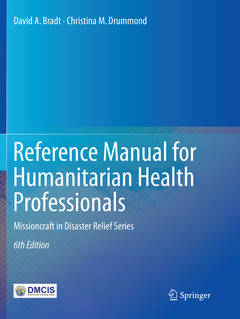Description
Reference Manual for Humanitarian Health Professionals (6th Ed., 6th ed. 2019)
Missioncraft in Disaster Relief® Series
Authors: Bradt David A., Drummond Christina M.
Language: English
Subject for Reference Manual for Humanitarian Health Professionals:
Keywords
disaster relief; public health preparedness and response; disaster competencies; disaster management; disaster epidemiology; natural and technological disasters and emergencies; field operations; humanitarian aid work; outbreak investigation; medical coordination; civil-military (civ-mil) cooperation; conflict-affected populations; missioncraft; rapid epidemiological assessment; refugees and displaced persons; sanitation; team leader; vector control; humanitarian health professionals; international health
Approximative price 94.94 €
In Print (Delivery period: 15 days).
Add to cartPublication date: 12-2018
Support: Print on demand
105.49 €
In Print (Delivery period: 15 days).
Add to cartPublication date: 11-2018
Support: Print on demand
Description
/li>Contents
/li>Biography
/li>Comment
/li>
The ReferenceManual for Humanitarian Health Professionals: Missioncraft in Disaster Relief is a hands-on resource written for disaster relief practitioners, educators, and researchers working in clinical medicine, public health, or disaster management.
?Missioncraft? is the art and science of preparing and conducting successful field operations. This manual provides state-of-the-art technical reference information developed from inter-disciplinary, inter-agency, and international best practices. It also provides tools and templates for health professionals addressing key disaster issues including security stabilization, rapid epidemiological assessment, environmental health, disease surveillance, epidemic preparedness, communicable disease control, standardized case management, referral practices, laboratory diagnostics, and medical logistics. Reference information and associated tools are presented in a concise, comprehensive, and structured format to help humanitarian health professionals plan, undertake, and manage high-impact interventions.
Sections are arranged in chronological order of essential activities in disaster relief operations:
· Pre-departure preparation
· Field briefing
· Field assessment
· Field recommendations
· Field reporting
· Field project and staff management
· Medical coordination
· Re-entry
The Reference Manual for Humanitarian Health Professionals is an authoritative resource for disaster health professionals in leadership roles in governmental, non-governmental, Red Cross, or UN agencies; health professionals anticipating future disaster deployment as agency medical coordinator, team leader, or health cluster coordinator; field-based staff responsible for health outcomes of disaster-affected populations; disaster relief specialists involved in strategic planning, project design and development, project management, monitoring and evaluation, and accountability to affected populations; educators and trainees in disaster health best practices; and, humanitarian researchers.
Acknowledgements
Introduction
Section 1 Pre-Departure Preparation
Guidance Notes
Core documents
1.1 Information
1.2 Personal Effects
Section 2 Field Briefing
Guidance Notes
Core Documents
2.1 Security Checklist
2.2 Medical Handover Checklist
Tools
2.T1 Health System Profile
2.T2 Emergency Management System Profile
2.T3 Subnational Jurisdictions2.T4 Layers of Conflict
2.T5 Meetings Calendar
2.T6 Disaster Response Chronology
Section 3 Field Assessment
Guidance Notes
Core Documents
3.1 Rapid Epidemiological Assessment
3.2 Site-specific Assessment
3.3 Feeding Center Assessment
Tools
3.T1 Pre-Existing Indicators
3.T2 Population and Infrastructure Damage Estimation
3.T3 Sectoral Gap Identification
Section 4 Field Recommendations
Guidance Notes
Core Documents4.1 Rapid Epidemiological Assessment Recommendations
Tools
4.T1 Recommendations WorksheetSection 5 Field Reporting
Guidance Notes
Core Documents
5.1 Rapid Epidemiological Assessment Report
5.2 Weekly Health Situation Report
5.3 Health Sector Status Summary
Section 6 Field Project and Staff Management
Guidance Notes
Core Documents6.1 Project Planning Overview
6.2 Project Plan of Action
Tools
6.T1 Project Map
6.T2 Logical Framework Definitions and Process6.T3 Logframe Template
6.T4 Project Monitoring and Evaluation Worksheet
6.T5 Remote Management Worksheet
6.T6 Disaster Medicine Staff Qualifications
Section 7 Medical Coordination
Guidance Notes
Core Documents
7.1 Medical Coordinator Generic Terms of Reference
7.2 Medical Coordinator Work Products
7.3 Health Cluster Principles of Coordination
Tools
7.T1 Health Cluster Meeting Agenda
7.T2 Health Cluster Meeting Process
Section 8 Technical Annexes
Guidance Notes
Annex 1 Humanitarian Programs
Annex 2 Security Sector
Annex 3 Health Sector
Annex 4 Tropical Medicine
Annex 5 Epidemic Preparedness and Response
Annex 6 Diagnostic Laboratory
Annex 7 Acronyms
Section 9 Resilience and Reentry
Guidance Notes
Epilogue
Author Biodata
The authors’ criterion-referenced qualifications inform their pursuit of Missioncraft. Each author possesses:
- current specialty board certifications or specialty college fellowships in clinical medicine and public health;
- organizational experience as disaster medical coordinator or team leader for governmental, non-governmental, United Nations, and Red Cross organizations;
- field experience as disaster medical coordinator or health advisor in two dozen or more countries on five continents;
- language fluency in two or more official UN languages;
- national or international awards for field excellence from governmental, non-governmental, and Red Cross organizations; and,
- Rockefeller Foundation support for manuscript development.
Provides guidance notes for optimizing use of the manual by diverse health professionals
Contains concise, comprehensive tools and templates for data gathering
Includes technical annexes with repositories of core technical information required in multiple domains of humanitarian health




